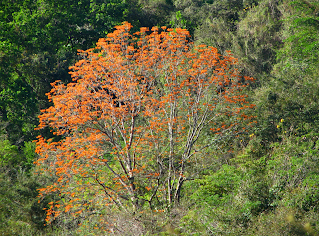Did you know the world's most venomous spider lives in Costa Rica?
The small spider on a gardenia flower is to soften what follows...
My eyes were drawn to a collard plant during a morning survey of the garden. Nestled between the leaves was a large spider eating a giant grasshopper. The spider's extremely plump body is what caught my attention. It's body was about two inches long and if the legs were stretched out it would add several inches. I checked on the spider a few hours later and it was still there, draining nutrients from the grasshopper. I didn't think much of it during the following days, other than to be careful knowing it was probably tucked away somewhere in the collard plant.
Almost every morning I pick up leaves the collard plant drops because it's infected with a bacterial disease. Friday morning I found a few leaves on the ground and on one I saw a large, white circular object. Upon closer inspection I found the big spider next to an enormous egg sac. Her body was no longer plump. I was a little sad for the spider because she probably chose a good place to deposit the eggs not knowing the plant was sick.
The leaf, spider and egg sac landed in a bad spot leaving her exposed and in need of relocation. The spider seemed docile and made no threatening moves, but I didn't feel comfortable moving her myself so I asked John for help. Initially, we moved her to a sheltered spot outside the garden. Then I began to have doubts about the relocation location. I thought about it over night and realized these spiders are really wonderful helpers with insect control in the garden. A day later we relocated her one more time back into the garden on an elevated and covered spot underneath the collard plant.
I researched the identity of this tropical spider and I think it's a type of Phoneutria or Wandering spider, it could be Phoneutria boliviensis. I did have a little freak out moment when I was reminded that the world's most venomous spider belongs to this family of spiders and does live in Costa Rica. It's called the Brazilian Wandering Spider. I do not believe she is that, however it would be a sad day to be bitten by any spider of that family. I considered moving her out of the garden yet again, but decided against it. The insect control they provide for the garden is valuable to me and she did choose to be there in the first place.






